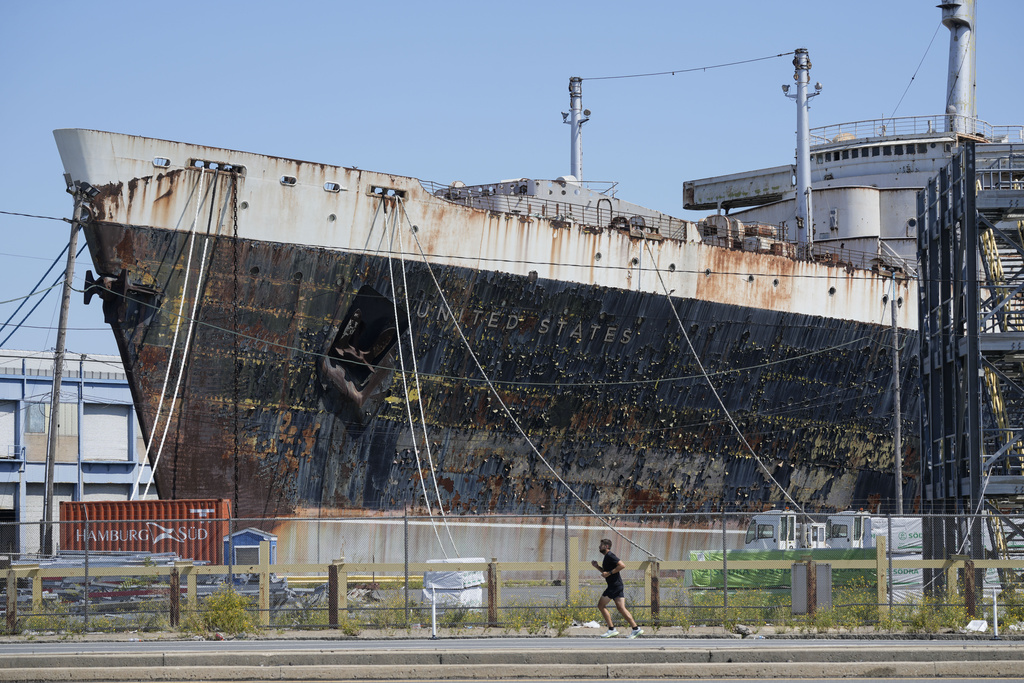SS United States Set for New Life as World’s Largest Artificial Reef \ Newslooks \ Washington DC \ Mary Sidiqi \ Evening Edition \ A long-standing rent dispute over the SS United States, a historic ocean liner, has been resolved, paving the way for the ship to be transformed into the world’s largest artificial reef off Florida’s Panhandle. The conservancy overseeing the ship reached a deal with Okaloosa County to sink the vessel as a new diving attraction, a project expected to generate millions in local tourism. After more than 70 years since its record-breaking transatlantic voyages, the ship will soon find a new purpose underwater.
SS United States to Become Artificial Reef After Legal Dispute: Quick Looks
- Dispute Resolved: The rent dispute between the SS United States Conservancy and Penn Warehousing has been settled, allowing the ship’s transfer.
- Artificial Reef Project: Okaloosa County in Florida plans to sink the vessel, turning it into the world’s largest artificial reef.
- Historic Ship: The SS United States still holds the transatlantic speed record, set in 1952.
- Tourism Boost: The new reef is expected to attract divers and generate millions in local tourism revenue.
- Lengthy Process Ahead: Cleaning, transporting, and sinking the ship will take at least 1.5 years to complete.
Deep Look
The historic SS United States, once a symbol of American engineering and a record-breaking ocean liner, is set to be transformed into the world’s largest artificial reef after a years-long rent dispute was finally resolved. The ocean liner, which has been docked in Philadelphia for decades, will soon be relocated and sunk off the coast of Okaloosa County, Florida, where it will serve as a unique underwater attraction.
The resolution of the rent dispute marks a significant step forward in the ship’s journey to a new purpose. In June, a federal judge had ruled that the SS United States Conservancy, which oversees the vessel, had until September 12 to present a plan to move the ship. The conservancy had previously been in conflict with Penn Warehousing, which doubled the ship’s daily dockage fees in 2021—a move that sparked a legal battle. The conservancy filed a lawsuit accusing Penn Warehousing of undermining efforts to sell the ship. After court-imposed mediation, the two parties finally reached a settlement, allowing the conservancy to proceed with its plans.
The conservancy has been working on a tentative agreement with Okaloosa County, located in Florida’s Panhandle, to turn the ship into an artificial reef. The deal, which was contingent upon settling the rent dispute, was officially announced last Friday. A small ceremony transferring the title of the ship took place on Saturday at the Philadelphia pier where the SS United States has been docked since the 1990s. However, the agreement still requires final approval from a federal judge before the project can move forward.
Okaloosa County plans to sink the 1,000-foot vessel, hoping it will become a prominent feature in its collection of over 500 artificial reefs. By turning the storied ship into a diving destination, local officials expect to generate millions of dollars annually in tourism revenue, boosting businesses such as scuba shops, charter fishing boats, and hotels. The SS United States, once a floating luxury liner, will soon be transformed into a barnacle-covered reef that supports marine life and draws underwater explorers from around the world.
A New Purpose for a Storied Ship
The SS United States, which was christened in 1952, remains one of the most celebrated ships in maritime history. It was originally designed to serve as both a passenger liner and a military vessel capable of transporting thousands of troops. The ship made headlines during its maiden voyage in 1952 when it shattered the transatlantic speed record, crossing the ocean in just three days, 10 hours, and 40 minutes—beating the previous record held by the RMS Queen Mary by 10 hours. The ship reached an average speed of 36 knots (about 41 mph), a record that still stands today for ocean liners.
After more than a decade of service, the SS United States was retired in 1969 and became part of the national reserve fleet. Over the years, various private owners tried to repurpose the ship, but those plans—ranging from luxury hotels to museums—proved either too costly or ill-timed. The ship has remained docked in South Philadelphia for decades, becoming a familiar but aging figure on the Delaware River waterfront.
As the years passed, the cost of maintaining the ship grew, and the conservancy, a nonprofit dedicated to preserving the vessel, struggled to raise funds. The escalating rent dispute with Penn Warehousing only added to the challenges, as the conservancy refused to pay a 2021 rate increase that doubled the daily dockage fee to $1,700. When the conservancy continued to pay its previous rate, Penn Warehousing terminated the lease in 2022. The legal wrangling that followed led to a trial earlier this year, where U.S. District Judge Anita B. Brody ultimately ruled that the conservancy had not breached its contract by refusing to pay the new rate, but the berthing agreement was deemed terminable with reasonable notice.
A Long Process Ahead
With the rent dispute settled, the process of turning the SS United States into an artificial reef can now begin, though it won’t happen overnight. The estimated cost of the project could exceed $10 million, and the complex task of cleaning, transporting, and safely sinking the ship will take considerable time—at least 1.5 years. The ship must be stripped of hazardous materials and prepared for submersion to ensure it does not harm the environment. Once the ship is sunk, it is expected to become a habitat for marine life and a popular destination for divers.
During a transfer of title ceremony held at the pier where the ship has been berthed for years, Thomas Watkins, a member of the SS United States Conservancy’s board, bid a heartfelt farewell to the historic vessel. “We can tell you that you will not be lost, you will not be forgotten, you will no longer be neglected and abused,” he said. “You will be rightly honored, cherished, and loved in a new home and in a new dimension. You will no longer be sailing the seas, but you will be surrounded and caressed by them.”
The transformation of the SS United States from a historic transatlantic liner to an artificial reef represents both an end and a new beginning for the ship. Although it will never sail again, the ship will continue to serve as a symbol of American innovation and engineering, while also contributing to marine conservation and local economic growth through tourism.
Looking Forward
For Okaloosa County, the sinking of the SS United States represents a significant addition to its already impressive array of artificial reefs. The ship will join over 500 other reefs, including sunken vessels, military equipment, and concrete structures, all aimed at supporting marine ecosystems and drawing divers to the region. The county expects the new reef to become a signature attraction that will generate millions of dollars in tourism revenue each year, benefitting local businesses and the broader community.
Officials from the county are optimistic about the project’s potential. “This is a once-in-a-lifetime opportunity,” said an Okaloosa County official. “We’re confident that this will become a cornerstone of our tourism strategy and a major attraction for divers and marine life enthusiasts from around the world.”
As the SS United States prepares to embark on its final journey, the ship will be remembered not only for its achievements on the seas but also for its new role as a submerged treasure beneath the waves.







